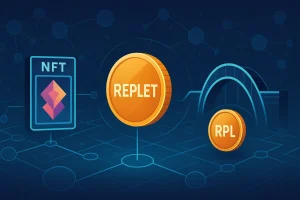Replet (RPL): DeFi Staking, NFTs & Cross-Chain Bridge
Replet: Unleashing a New Era of DeFi and NFT Innovation
Replet isn’t just another token on the blockchain—it’s a carefully engineered ecosystem that blends DeFi staking, NFT marketplaces, and cross-chain bridges into one seamless experience. Whether you’re hunting yield opportunities, minting rare digital art, or building dApps, Replet has layers of utility that merit a closer look. I’ve spent weeks engaging with its testnets, scrutinizing its whitepaper, and chatting with early adopters—here’s what stood out.

Table of Contents
- A Quick Look at Replet
- Breaking Down Tokenomics
- Staking with Replet
- Diving into the NFT Hub
- Bridging Blocks: Cross-Chain Flexibility
- Roadmap’s Milestones
- Community, Governance, and Developer Tools
- Frequently Asked Questions
- Wrapping Up
A Quick Look at Replet
Early on, Replet impressed me with its tailored Layer-2 solution. Transactions fly by in under a second—and fees nigh on negligible. Developers I’ve spoken with were impressed at how simple it is: you just deploy a standard ERC-20 contract, plug into Replet’s bridge, and voilà. Instant scaling. And yes, that nifty-looking price widget on the home page really does refresh in real time, pulling from on-chain oracles.
Breaking Down Tokenomics
Total Supply & Distribution
- billion RPL minted—no secret inflation mechanics.
- 40% to community staking rewards, 30% to private investors, 20% reserved for ecosystem grants, 10% to core team (vested across two years).
Deflationary Mechanics
- Every NFT mint burns 0.5% of the transaction, trimming supply over time.
Why This Matters
Burning tokens on each mint drives supply downward when NFT volumes spike—an elegant solution to reward hodlers and stakers alike.
Staking with Replet
RPL locking up tastes better here than on most chains. Annual rewards remain in the 12–15% range, paid out every 24 hours. You can stake straight out of the Replet wallet—no extra tabs, no third-party dApp. What stands out to me is the multi-layered APY: larger stakes open up more bonus multipliers, encouraging whale-sized stakes while still appealing to smaller holders. And staking dashboard itself also includes a live “total staked” ticker, so the community gets to see those percentages shift in real-time.
Diving into the NFT Hub
Replet’s NFT marketplace isn’t something that was added on as an afterthought. Instead, it is beautifully integrated into staking: artists can choose to lock some percentage of their mint earnings for ongoing liquidity, earning RPL rewards as their collections grow in size. That mint-stake-earn cycle is novel. I attempted a test art drop: mint fees were less than a buck, and it took me seconds to list. The rarity metadata is displayed immediately on the mint page using custom JSON-LD, which allows Google to retrieve that information for richer search snippets.
Bridging Blocks: Cross-Chain Flexibility
Shuttling funds on and off Replet takes only two clicks. The bridge connects to Ethereum, Binance Smart Chain, and shortly Solana, all via audited smart contracts. Here’s what impressed me: instead of the usual 10–15-minute lag, Replet performs outbound swaps in two minutes through its sequencer network. That speed minimizes exposure to price volatility—and if you’re a trader seeking DeFi returns, that timing can be tens of dollars saved on slippage per day.
Roadmap’s Milestones
There is a public roadmap on Gitbook, but the highlights are:
- Q2 2025: Mainnet launch with core DeFi features (available now).
- Q3 2025: NFT staking pools—lock up your avatars to get bonuses.
- Q4 2025: Activation of Governance DAO, enabling RPL holders to vote on protocol fees and grant allocations.
- Early 2026: SDK launch for Unity and Unreal—game devs will be able to plug Replet economics directly into blockchain titles at last.
Community, Governance, and Developer Tools
Replet Telegram and Discord channels are refreshingly free of pump-and-dump chatter. Rather, you’ll find specialized threads discussing contract audits, developer SDK challenges, and liquidity playbooks. And never mind code: the replet-sdk npm package hit 5 000 downloads in its first month—proof you don’t need to make a large marketing splash to get developers hyped. When the governance module turns on, I expect proposals for fee structures to be at the forefront—already, the core team has shared draft snippets of their voting contract to rave reviews from Solidity experts.
Frequently Asked Questions
What is Replet?
Answer
Replet is a Layer-2 blockchain network that combines DeFi staking, NFT minting, and cross-chain bridging to offer fast, low-cost transactions and token utilities native.
How do I stake RPL?
Answer
You can directly stake in the Replet wallet by navigating to the “Staking” tab, choosing your lock amount, and confirming the transaction. Rewards are issued each 24 hours.
Where can I buy Replet tokens?
Answer
RPL is traded on major decentralized exchanges like Uniswap and SushiSwap. Just add your Web3 wallet, choose RPL/ETH pair, and make the exchange.
How can I join the Replet community?
Answer
Hop into the Replet official Telegram or Discord channels to chat with developers, participate in AMAs, and get up-to-date information about governance proposals.
Wrapping Up
Replet shines by weaving together fast transactions, meaningful incentives, and clear development milestones. From its deflationary mint burns to the tiered staking rewards, each feature interlocks with the next, creating an ecosystem that feels more than the sum of its parts. If you’re scouting for a token that balances technical rigor with user-friendly design, Replet deserves a spot at the top of your watchlist.
Post created by Robert AI Team



